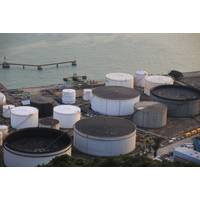Chinese Companies Shy Away From Russian Oil

Chinese state oil companies are shying away from Russian oil this month, with two importers halting purchases while two others scaled back volumes as they assess compliance following recent U.S. sanctions on Moscow, multiple trade sources said.Russian oil supplies to top buyers India and China fell sharply following the January 10 sanctions by the former Biden administration targeting Russian producers Gazprom Neft and Surgutneftegaz as well as insurers and more than 100 vessels to curtail Moscow's oil revenue.While Russian shipments to the two Asian countries have rebounded after more non-sanctioned tankers joined the trade…
Upset by Trump's Iran Waivers, Saudis Push for Deep Oil Output Cut

When U.S. President Donald Trump asked Saudi Arabia this summer to raise oil production to compensate for lower crude exports from Iran, Riyadh swiftly told Washington it would do so.But Saudi Arabia did not receive advance warning when Trump made a U-turn by offering generous waivers that are keeping more Iranian crude in the market instead of driving exports from Riyadh's arch-rival down to zero, OPEC and industry sources say.Angered by the U.S. move that has raised worries about over supply, Saudi Arabia is now considering cutting output with OPEC and its allies by about 1.4 million barrels per day (bpd) or 1.5 percent of global supply…
Libya's NOC Withholding Total's Share of Waha Crude
Libya's National Oil Corp (NOC) is withholding Total's share of crude from the Waha concession as a dispute drags on over the French oil major's purchase of Marathon's stake in the concession two months ago, Libyan oil and industry sources said.Total closed a $450 million deal to buy Marathon Oil's 16.33 percent stake in Waha in March, but the deal drew criticism in Libya and the NOC is currently examining whether to intervene in one way or another.Total, which has already paid Marathon for the stake, says it informed the Libyan authorities about the deal in advance and they raised no objections at the time.However…
Libya Oil Output at Around 1.05 mln bpd

OPEC member Libya's oil output is at around 1.05 million barrels per day despite a continuing outage since February at its 70,000 bpd El Feel oilfield, a Libyan oil source told Reuters on Friday. A second Libyan oil source said production was lately fluctuating more or less around the 1.1 million bpd level. It is common for Libyan production to fluctuate due to poor infrastructure in the country. The western El Feel oilfield was shut on Feb. 23 and state-owned National Oil Corp declared force majeure on crude loadings at the Mellitah oil terminal the following day.
Libya's El Feel Oilfield Production Unaffected by Protests

Oil production at Libya's El Feel has not been affected so far by ongoing protests, and the oilfield is pumping around 70,000 barrels per day, a Libyan oil source told Reuters on Thursday. Some workers at the field were evacuated after guards withdrew in a protest over pay, a local source from the town of Murzuq said on Wednesday. The field is operated by Mellitah, a joint venture between Libya's National Oil Corporation (NOC) and Italy's Eni. Reporting by Ahmad Ghaddar
Libyan Crude Pipeline Blast Blamed on Attackers
Armed men blew up a Libyan pipeline pumping crude oil to Es Sider port on Tuesday, reducing the North African country's output by around 90,000 barrels a day, military and oil sources said. The attackers arrived at the site near Marada in two cars and planted explosives on the pipeline, a military source said. Pictures purportedly showing a huge cloud from the blast in central eastern Libya circulated on social media. The damage was still being assessed, one oil source said. Oil prices rose on the report. Islamic State fighters had a presence in the area until government forces expelled them from their main stronghold in Sirte a year ago.
Libyan Pipeline Blast Reported Near Es Sider
There has been an explosion at a Libyan crude oil pipeline that feeds the Es Sider sea terminal, a Libyan oil source said on Tuesday. The blast happened near Marada, the source said, adding that the pipeline belonged to the Waha oil company. No more details were immediately available. Reporting by Ayman al-Warfalli
Oil Falls Below $56 on Signs of Higher Output
Oil fell more than $1 a barrel to below $56 on Monday as a rise in U.S. drilling and higher OPEC output put the brakes on a rally that helped prices to register their biggest third-quarter gain in 13 years. U.S. energy companies added oil rigs for the first week in seven and Iraq announced its exports rose slightly in September while OPEC overall boosted output, a Reuters survey showed. Brent crude, the global benchmark, was down $1.02 at $55.77 a barrel at 1310 GMT. It notched a third-quarter gain of about 20 percent, the biggest third-quarter increase since 2004 and traded as high as $59.49 last week.
Middle East Oil Producers Turn to Crude Trading to Boost Incomes
Middle East oil producers are venturing into trading crude as three years of weak oil prices has encouraged them to find new sources of income beyond the business of exporting their output. OPEC kingpin Saudi Arabia, the world's biggest oil exporter, is among those making the shift. A subsidiary of state-owned Saudi Aramco plans to start trading non-Saudi crude, according to sources familiar with the issue. Other members of the Organization of the Petroleum Exporting Countries are joining in as oil prices remain at roughly half their levels of mid-2014.
Saudis Tighten Grip on Japan, its Biggest Asian Oil Market
Japan's H1 2017 Saudi crude imports rise 7.7 pct; Japan is top buyer of Saudi oil in Asia at 1.3 mln bpd in H1. Saudi Arabia has boosted its market share in Japan, the world's top oil exporter's biggest Asian market, by selling more light crude to the country as a way to offset revenue lost implementing OPEC's production cuts. Middle East crude sellers consider Japan, the world's fourth-largest oil importer, a premium market since its refiners will pay more to secure supply than other Asian buyers. Saudi Arabia raises revenue…
Oil Prices Pause after Sharp Falls

Oil prices edged higher on Monday, pausing for breath after coming under pressure over the past month from rising production in the United States, Libya and Nigeria, which has taken the edge off an OPEC-led initiative to support the market by cutting production. Brent crude futures were trading 17 cents higher at $47.54 per barrel by 1015 GMT. U.S. West Texas Intermediate (WTI) crude futures were 15 cents higher at $44.89 per barrel. Both benchmarks are down some 13 percent since late May, when producers led by the Organization…
Oil Prices Fall After Libyan Oilfields Restart
Oil prices fell on Thursday after news that two key oilfields in Libya had restarted, pumping crude for export into an already bloated market. Benchmark Brent crude fell $1.22 a barrel to a low of $50.60 before recovering slightly to around $50.80 by 1330 GMT. The contract has fallen more than 10 percent from this month's peak. U.S. light crude oil hit a low of $48.51, down $1.11 a barrel on the day. Libya's Sharara oilfield, with a production capacity of almost 300,000 barrels per day (bpd), has restarted after the end of protests that had blocked pipelines there, a Libyan oil source and local official said on Thursday.
Oil Approaches $56 on Libya, Syria Troubles
Libya's Sharara oilfield shut again; Brent likely to touch $60 at times in second quarter. Oil rose towards $56 a barrel on Monday, supported by another shutdown at Libya's largest oilfield and heightened tension over Syria following the U.S. missile strike. Libya's Sharara oilfield was shut on Sunday after a group blocked a pipeline linking it to an oil terminal, a Libyan oil source said. The field had only just returned to production, after a week-long stoppage ending in early April. "It means that at least one potential source of additional supply has fallen away for the time being…
Armed faction enters major Libyan oil port
An armed faction entered a major Libyan oil terminal and a nearby airport on Friday, after attacking forces that have controlled the terminals since September, officials and residents said. The terminals at Es Sider and Ras Lanuf are two of Libya's largest, with potential combined production capacity of about 600,000 barrels per day (bpd). The new uncertainty over their status could be a blow to Libya's hopes of further reviving its oil production. It was unclear who controlled the ports late on Friday. There was no statement from the Libyan National Oil Corporation (NOC) in Tripoli…
Peru Diversifies Crude Imports
Peru has started expanding the sources of its crude imports, slowly introducing U.S. and Brazilian grades to a slate mostly based on oil from Ecuador, Africa and Trinidad and Tobago, according to Thomson Reuters Trade Flows data. The numbers show Peru has joined the growing list of Latin American countries increasing purchases of U.S. light crudes for their refineries since an export ban was lifted in late 2015. "Buying other crudes is a result of a wider variety due to U.S. crude exports. We always choose the option with the best economic value for us…
Maersk Could Lose Qatar field, its Largest Oil Asset
Denmark's A.P. Moller-Maersk said for the first time on Wednesday there was a risk it could lose its largest oil producer, a 300,000 barrel per day Qatari field, and may not replace the production by buying other assets. Chief Executive Nils Smedegaard Andersen's comments give some insight into Maersk's view of how the oil industry will evolve, after oil prices more than halved in the past two years. The recently-streamlined conglomerate still considers Maersk Oil as core to its business and for years the expectation was that the Qatar field would be part of this as Maersk would renew a 25-year production agreement when its licence ran out in 2017.
Signs Point to Deal on Oil Output- Kuwait OPEC Official, Sources
All signs suggest a meeting of oil-producing countries on April 17 will deliver an agreement to freeze output, Kuwait's OPEC governor and two sources said, suggesting Iran's aim to raise supply will not scupper a deal aimed at supporting prices. The Kuwaiti governor, Nawal Al-Fuzaia, also said in a speech at the country's oil ministry that she expected the oil market to achieve a balance between supply and demand in the second half of this year, leading to higher average prices. "There are positive indications an agreement will be reached during this meeting ... an initial agreement on freezing production," she said.
Iraq's Southern Oil Exports Rebound
Iraq's southern oil exports have risen more than 300,000 barrels per day (bpd) so far in November, according to loading data and an industry source, bringing shipments from OPEC's second-largest producer back towards a monthly record. The increase, after bad weather slowed shipments in October, is an indication of continued high output from major members of the Organization of the Petroleum Exporting Countries, which looks set to keep policy steady at a meeting next week. Exports from Iraq's southern terminals have averaged 3.05 million bpd in the first 24 days of this month, up from 2.70 million bpd in October.
Iraqis Selling Crude at $30 as OPEC Mulls Strategy
Iraq oil source sees flat to higher 2016 southern exports; BP says difficult to see large rise in Iraq output in 2016. Iraq may increase oil output further in 2016, although less dramatically than this year, intensifying a battle for market share between OPEC members and non-OPEC rivals that has forced Baghdad to sell some crude grades for as little as $30 a barrel. Iraq's output in 2015 has jumped almost 500,000 barrels per day (bpd), or 13 percent, according to the International Energy Agency (IEA). That has made Iraq the world's fastest source of supply growth and a key driver of surging OPEC production.
OPEC Focuses on Rival Mega Projects
Big deep water projects vulnerable to low price; shale oil adjusts swiftly to price volatility. After almost a year of painfully low oil prices, OPEC members are beginning to believe they are winning against upstart U.S. shale producers in a short-term market share contest. Yet insiders and experts say OPEC is looking for a longer-lasting impact on other high-cost production oil field plans, many in deep oceans, with bigger time scales, even if that means a period of cheap oil prices lasting for years. Privately, OPEC's core Gulf members say they have resigned themselves to the idea that the U.S.